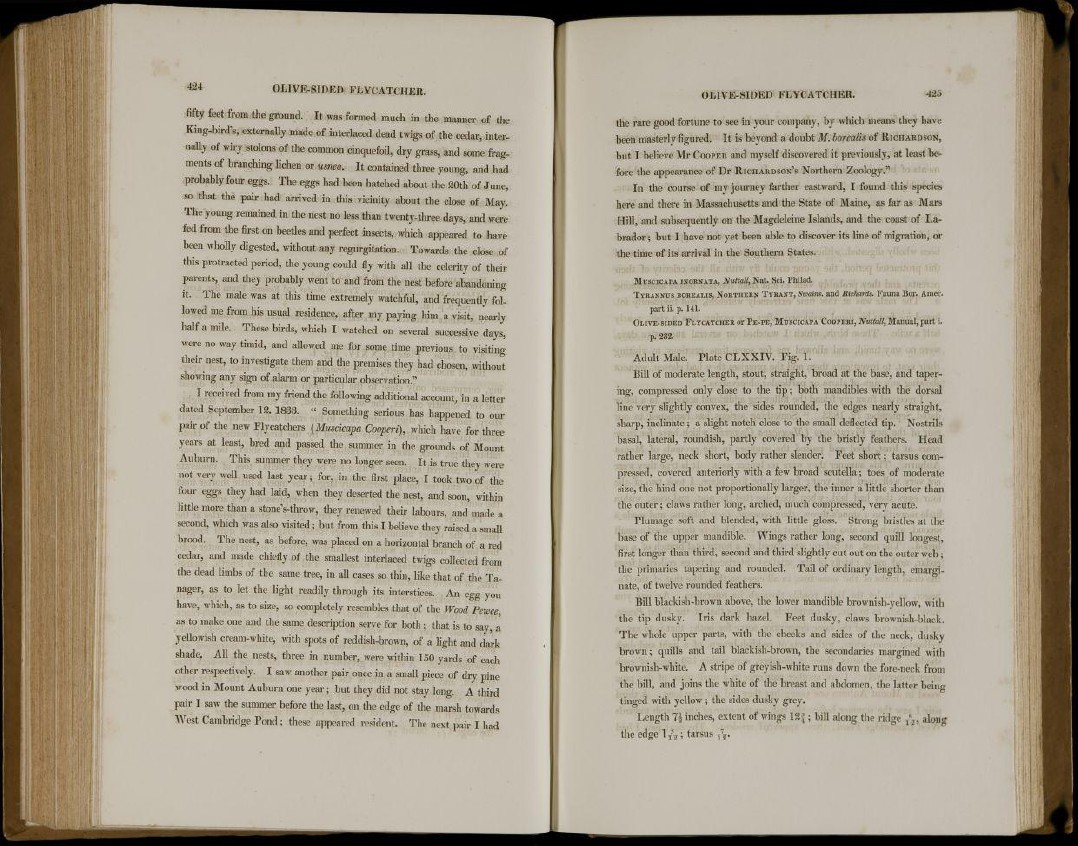
424 O L I V E - S I D E D F L Y C A T C H E R .
fifty feet from the ground. It was formed much in the manner of the
King-bird's, externally made of interlaced dead twigs of the cedar, internally
of wiry stolons of the common cinquefoil, dry grass, and some fragments
of branching lichen or usnea. It contained three young, and had
probably four eggs. The eggs had been hatched about the 20th of J une,
so that the pair had arrived in this vicinity about the close of May.
The young remained in the nest no less than twenty-three days, and were
fed from the first on beetles and perfect insects, which appeared to have
been wholly digested, without any regurgitation. Towards the close of
this protracted period, the young could fly with all the celerity of their
parents, and they probably went to and from the nest before abandoning
it. The male was at this time extremely watchful, and frequently followed
me from his usual residence, after my paying him a visit, nearly
half a mile. These birds, which I watched on several successive days,
were no way timid, and allowed me for some time previous to visiting
their nest, to investigate them and the premises they had chosen, without
showing any sign of alarm or particular observation."
I received from my friend the following additional account, in a letter
dated September 12. 1833. " Something serious has happened to our
pair of the new Flycatchers (Muscícapa Cooperi), which have for three
years at least, bred and passed the summer in the grounds of Mount
Auburn. This summer they were no longer seen. It is true they were
not very well used last year; for, in the first place, I took two of the
four eggs they had laid, when they deserted the nest, and soon, within
little more than a stone's-throw, they renewed their labours, and made a
second, which was also visited; but from this I believe they raised a small
brood. The nest, as before, was placed on a horizontal branch of a red
cedar, and made chiefly of the smallest interlaced twigs collected from
the dead limbs of the same tree, in all cases so thin, like that of the Tanager,
as to let the light readily through its interstices. An egg you
have, which, as to size, so completely resembles that of the Wood Pezvee,
as to make one and the same description serve for both; that is to say, a
yellowish cream-white, with spots of reddish-brown, of a light and dark
shade, All the nests, three in number, were within 150 yards of each
other respectively. I saw another pair once in a small piece of dry pine
wood in Mount Auburn one year; but they did not stay long. A third
pair I saw the summer before the last, on the edge of the marsh towards
West Cambridge Pond; these appeared resident. The next pair I had
O L I V E - S I D E D F L Y C A T C H E R . 425
the rare good fortune to see in your company, by which means they have
been masterly figured. It is beyond a doubt M. borealis of RICHARDSON,
but I believe Mr COOPER and myself discovered it previously, at least before
the appearance of Dr RICHARDSON'S Northern Zoology.""
In the course of my journey farther eastward, I found this species
here and there in Massachusetts and the State of Maine, as far as Mars
Hill, and subsequently on the Magdeleine Islands, and the coast of Labrador
; but I have not yet been able to discover its line of migration, or
the time of its arrival in the Southern States.
MUSCICAPA INORNATA, Nuttall, Nat. Sci. Philad.
TYRANNUS HOREALIS, NORTHERN TYRANT, Swains, and Richards. Fauna Bor. Amer.
part ii. p. 141.
OLIVE-SIDED FLYCATCHER or PE-PE, MUSCICAPA COOPERI, Nuttall, Manual, part i.
p. 282.
Adult Male. Plate CLXXIV. Fig. 1.
Bill of moderate length, stout, straight, broad at the base, and tapering,
compressed only close to the tip; both mandibles with the dorsal
line very slightly convex, the sides rounded, the edges nearly straight,
sharp, inclinate ; a slight notch close to the small deflected tip. Nostrils
basal, lateral, roundish, partly covered by the bristly feathers. Head
rather large, neck short, body rather slender. Feet short; tarsus compressed,
covered anteriorly with a few broad scutella; toes of moderate
size, the hind one not proportionally larger, the inner a little shorter than
the outer; claws rather long, arched, much compressed, very acute.
Plumage soft and blended, with little gloss. Strong bristles at the
base of the upper mandible. Wings rather long, second quill longest,
first longer than third, second and third slightly cut out on the outer web;
the primaries tapering and rounded. Tail of ordinary length, emarginate,
of twelve rounded feathers.
Bill blackish-brown above, the lower mandible brownish-yellow, with
the tip dusky. Iris dark hazel. Feet dusky, claws brownish-black.
The whole upper parts, with the cheeks and sides of the neck, dusky
brown; quills and tail blackish-brown, the secondaries margined with
brownish-white. A stripe of greyish-white runs down the fore-neck from
the bill, and joins the white of the breast and abdomen, the latter being
tinged with yellow; the sides dusky grey.
Length % inches, extent of wings 12? ; bill along the ridge ft, along
the edge 1ft ; tarsus ft.